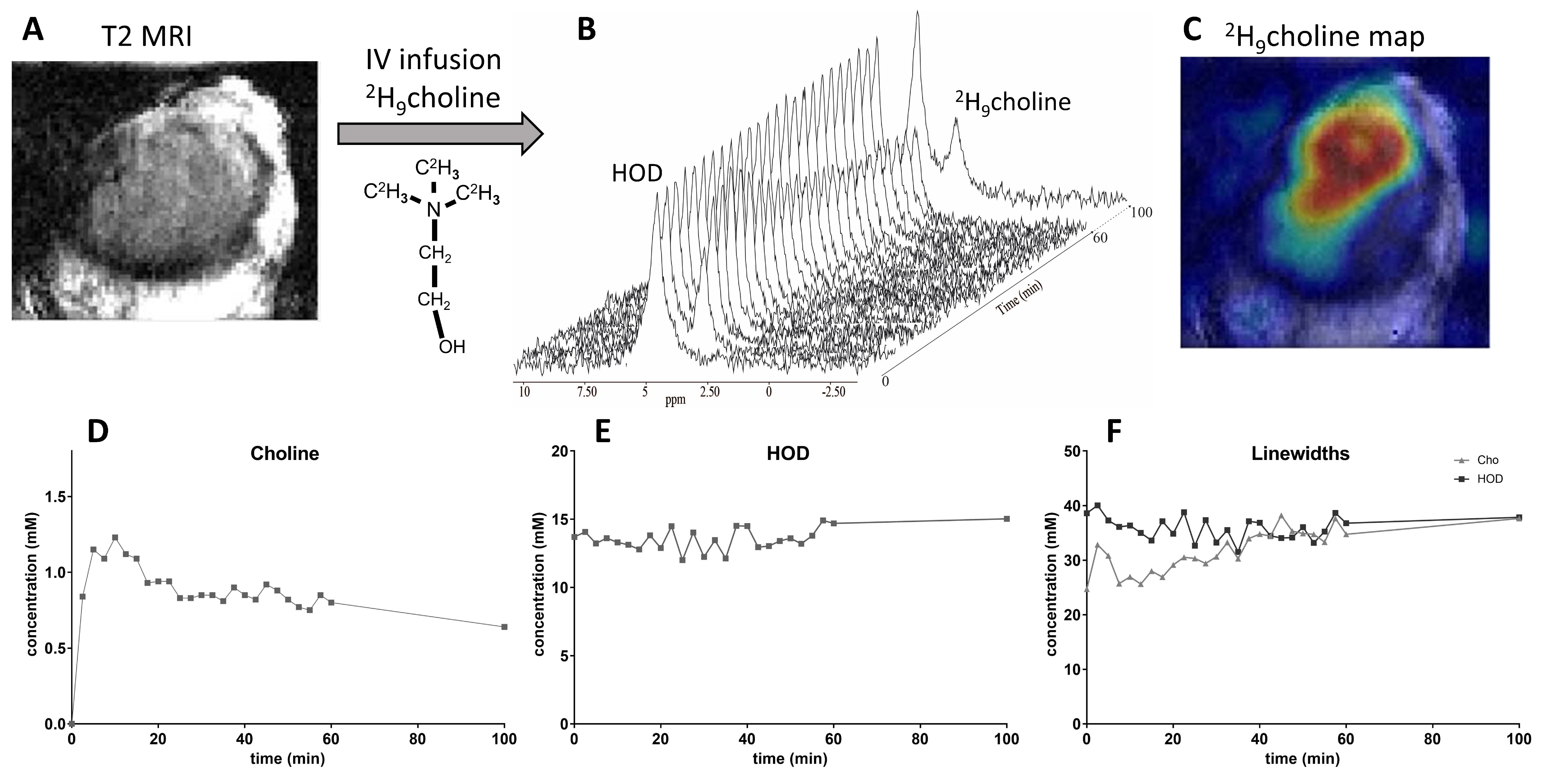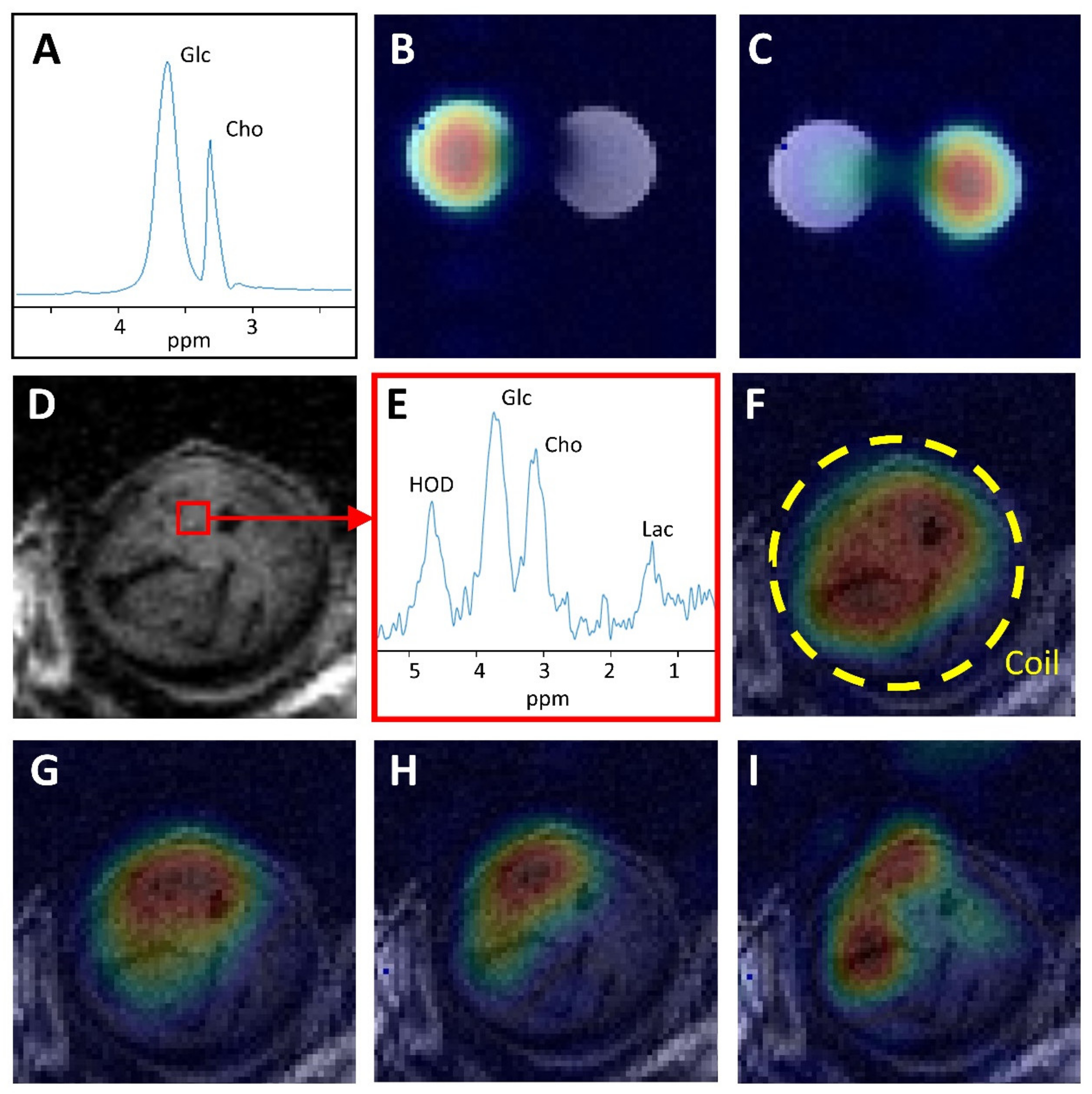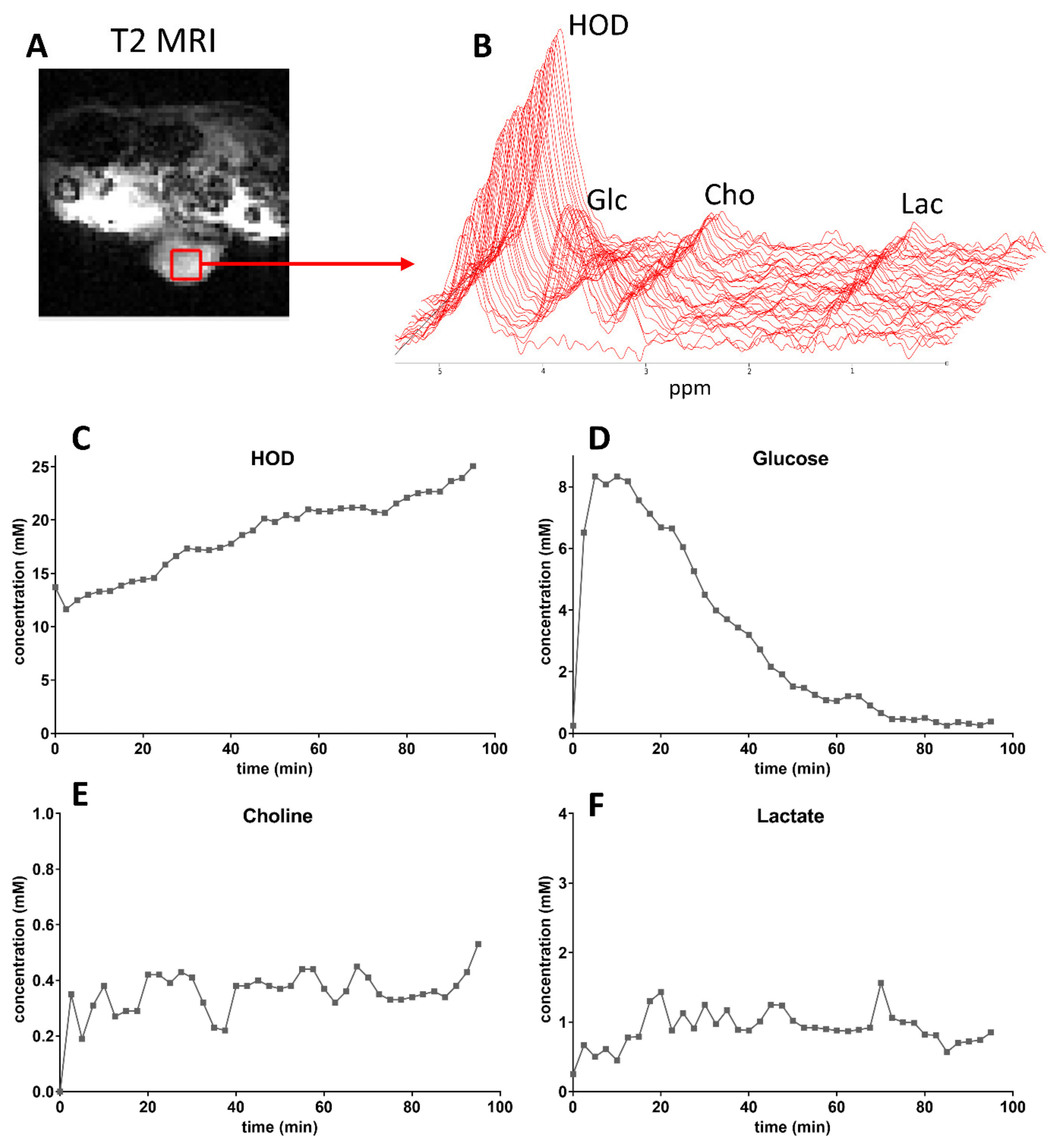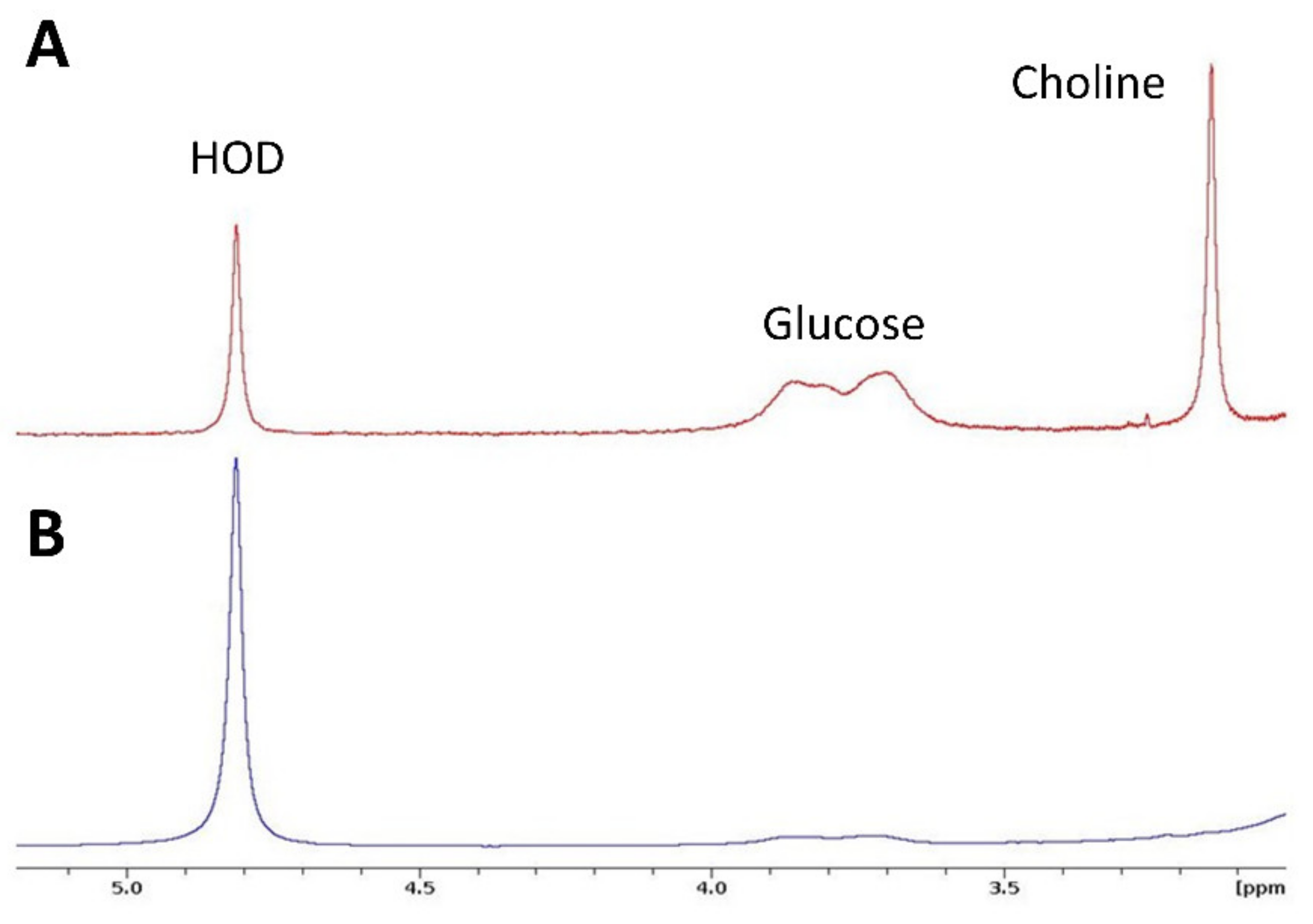Simultaneous Recording of the Uptake and Conversion of Glucose and Choline in Tumors by Deuterium Metabolic Imaging
Abstract
Simple Summary
Abstract
1. Introduction
2. Materials and Methods
2.1. Tumors and Animal Handling
2.2. MR Hardware and IV Infusions
2.3. Deuterium MR Spectroscopy and Imaging
2.4. Data Processing
2.5. Blood Samples
3. Results
DMS and DMI of Renal Tumor after [2H9]choline Infusion
4. Discussion
5. Conclusions
Author Contributions
Funding
Institutional Review Board Statement
Informed Consent Statement
Data Availability Statement
Acknowledgments
Conflicts of Interest
References
- Gambhir, S.S. Molecular imaging of cancer with positron emission tomography. Nat. Rev. Cancer 2002, 2, 683–693. [Google Scholar] [CrossRef]
- Rothman, D.L.; De Graaf, R.A.; Hyder, F.; Mason, G.F.; Behar, K.; De Feyter, H.M. In vivo 13 C and 1 H-[ 13 C] MRS studies of neuroenergetics and neurotransmitter cycling, applications to neurological and psychiatric disease and brain cancer. NMR Biomed. 2019, 32, e4172. [Google Scholar] [CrossRef] [PubMed]
- Wijnen, J.P.; Van Der Graaf, M.; Scheenen, T.W.; Klomp, D.W.; De Galan, B.E.; Idema, A.J.; Heerschap, A. In vivo 13C magnetic resonance spectroscopy of a human brain tumor after application of 13C-1-enriched glucose. Magn. Reson. Imaging 2010, 28, 690–697. [Google Scholar] [CrossRef]
- Brender, J.R.; Kishimoto, S.; Merkle, H.; Reed, G.; Hurd, R.E.; Chen, A.P.; Ardenkjaer-Larsen, J.H.; Munasinghe, J.; Saito, K.; Seki, T.; et al. Dynamic Imaging of Glucose and Lactate Metabolism by 13C-MRS without Hyperpolarization. Sci. Rep. 2019, 9, 3410. [Google Scholar] [CrossRef]
- Kurhanewicz, J.; Vigneron, D.B.; Ardenkjaer-Larsen, J.H.; Bankson, J.A.; Brindle, K.; Cunningham, C.; Gallagher, F.A.; Keshari, K.R.; Kjaer, A.; Laustsen, C.; et al. Hyperpolarized 13C MRI: Path to Clinical Translation in Oncology. Neoplasia 2019, 21, 1–16. [Google Scholar] [CrossRef]
- Rodrigues, T.; Serrao, E.M.; Kennedy, B.W.; Hu, D.-E.; Kettunen, M.; Brindle, K.M. Magnetic resonance imaging of tumor glycolysis using hyperpolarized 13C-labeled glucose. Nat. Med. 2014, 20, 93–97. [Google Scholar] [CrossRef]
- Van Zijl, P.C.; Yadav, N.N. Chemical exchange saturation transfer (CEST): What is in a name and what isn’t? Magn. Reson. Med. 2011, 65, 927–948. [Google Scholar] [CrossRef]
- Lu, M.; Zhu, X.-H.; Zhang, Y.; Mateescu, G.; Chen, W. Quantitative assessment of brain glucose metabolic rates using in vivo deuterium magnetic resonance spectroscopy. Br. J. Pharmacol. 2017, 37, 3518–3530. [Google Scholar] [CrossRef] [PubMed]
- De Feyter, H.M.; Behar, K.L.; Corbin, Z.A.; Fulbright, R.K.; Brown, P.B.; McIntyre, S.; Nixon, T.W.; Rothman, D.L.; de Graaf, R.A. Deuterium metabolic imaging (DMI) for MRI-based 3D mapping of metabolism in vivo. Sci. Adv. 2018, 4, eaat7314. [Google Scholar] [CrossRef]
- De Feyter, H.M.; de Graaf, R.A. Deuterium metabolic imaging—Back to the future. J. Magn. Reson. 2021, 326, 106932. [Google Scholar] [CrossRef]
- Kreis, F.; Wright, A.J.; Hesse, F.; Fala, M.; Hu, D.-E.; Brindle, K.M. Measuring Tumor Glycolytic Flux in Vivo by Using Fast Deuterium MRI. Radiology 2020, 294, 289–296. [Google Scholar] [CrossRef]
- Glunde, K.; Bhujwalla, Z.M.; Ronen, S.M. Choline metabolism in malignant transformation. Nat. Rev. Cancer 2011, 11, 835–848. [Google Scholar] [CrossRef]
- Hara, T. Review11C-Choline and 2-Deoxy-2-[18F]Fluoro-D-Glucose in Tumor Imaging with Positron Emission Tomography. Mol. Imaging Biol. 2002, 4, 267–273. [Google Scholar] [CrossRef]
- Treglia, G.; Giovannini, E.; Di Franco, D.; Calcagni, M.L.; Rufini, V.; Picchio, M.; Giordano, A. The role of positron emission tomography using carbon-11 and fluorine-18 choline in tumors other than prostate cancer: A systematic review. Ann. Nucl. Med. 2012, 26, 451–461. [Google Scholar] [CrossRef]
- Kobus, T.; Wright, A.J.; Scheenen, T.W.J.; Heerschap, A. Mapping of prostate cancer by 1 H MRSI. NMR Biomed. 2013, 27, 39–52. [Google Scholar] [CrossRef] [PubMed]
- Peeters, T.H.; van Uden, M.J.; Rijpma, A.; Scheenen, T.W.; Heerschap, A. 3D 31 P MR spectroscopic imaging of the human brain at 3 T with a 31 P receive array: An assessment of 1 H decoupling, T 1 relaxation times, 1 H- 31 P nuclear Overhauser effects and NAD +. NMR Biomed. 2021, 34, e4169. [Google Scholar] [CrossRef]
- Esmaeili, M.; Hamans, B.C.; Navis, A.; Van Horssen, R.; Bathen, T.F.; Gribbestad, I.S.; Leenders, W.; Heerschap, A. IDH1 R132H Mutation Generates a Distinct Phospholipid Metabolite Profile in Glioma. Cancer Res. 2014, 74, 4898–4907. [Google Scholar] [CrossRef] [PubMed]
- Vanhamme, L.A.; Boogaart, A.V.D.; Van Huffel, S. Improved Method for Accurate and Efficient Quantification of MRS Data with Use of Prior Knowledge. J. Magn. Reson. 1997, 129, 35–43. [Google Scholar] [CrossRef] [PubMed]
- Freeman, J.J.; Choi, R.L.; Jenden, D.J. Plasma choline: Its turnover and exchange with brain choline. J. Neurochem. 1975, 24, 729–734. [Google Scholar] [CrossRef]
- Katz-Brull, R.; Margalit, R.; Bendel, P.; Degani, H. Choline metabolism in breast cancer; 2H-, 13C- and 31P-NMR studies of cells and tumors. MAGMA 1998, 6, 44–52. [Google Scholar] [CrossRef]
- Ip, K.L.; Khunte, A.; Behar, K.L.; de Graaf, R.A.; de Feyter, H.M. Mapping of exogenous choline uptake in brain tumors in vivo using deuterium metabolic imaging (DMI). In Proceedings of the International Society of Magnetic Resonance in Medicine; Virtual. 2021. Available online: https://www.ismrm.org/20/program_files/O41.htm (accessed on 9 August 2021).
- Ueland, P.M. Choline and betaine in health and disease. J. Inherit. Metab. Dis. 2010, 34, 3–15. [Google Scholar] [CrossRef]
- De Feyter, H.M.; Thomas, M.A.; Ip, K.L.; Behar, K.I.; de Graaf, R.A. Delayed mapping of 2H-labeled choline using Deuterium Metabolic Imaging (DMI) reveals active choline metabolism in rat glioblastoma. In Proceedings of the International Society of Magnetic Resonance in Medicine. Virtual 2021, 29, 0016. [Google Scholar]
- Agut, J.; Font, E.; Sacristán, A.; Ortiz, J.A. Dissimilar effects in acute toxicity studies of CDP-choline and choline. Arzneimittelforschung 1983, 33, 1016–1018. [Google Scholar]
- Modinger, Y.; Schon, C.; Wilhelm, M.; Hals, P.A. Plasma Kinetics of Choline and Choline Metabolites after a Single Dose of SuperbaBoost(TM) Krill Oil or Choline Bitartrate in Healthy Volunteers. Nutrients 2019, 11, 2548. [Google Scholar] [CrossRef]
- Buchman, A.L.; Jenden, D.J.; Moukarzel, A.A.; Roch, M.; Rice, K.M.; Chang, A.S.; Ament, M.E. Choline pharmacokinetics during intermittent intravenous choline infusion in human subjects. Clin. Pharmacol. Ther. 1994, 55, 277–283. [Google Scholar] [CrossRef] [PubMed]
- Friesen-Waldner, L.J.; Wade, T.P.; Thind, K.G.; Chen, A.P.; Gomori, J.M.; Sosna, J.; McKenzie, C.A.; Katz-Brull, R. Hyperpolarized choline as an MR imaging molecular probe: Feasibility of in vivo imaging in a rat model. J. Magn. Reson. Imaging 2015, 41, 917–923. [Google Scholar] [CrossRef] [PubMed]
- Cudalbu, C.; Comment, A.; Kurdzesau, F.; Van Heeswijk, R.B.; Uffmann, K.; Jannin, S.; Denisov, V.; Kirik, D.; Gruetter, R. Feasibility of in vivo15N MRS detection of hyperpolarized 15N labeled choline in rats. Phys. Chem. Chem. Phys. 2010, 12, 5818–5823. [Google Scholar] [CrossRef]
- Kumar, M.; Arlauckas, S.P.; Saksena, S.; Verma, G.; Ittyerah, R.; Pickup, S.; Popov, A.V.; Delikatny, E.J.; Poptani, H. Magnetic Resonance Spectroscopy for Detection of Choline Kinase Inhibition in the Treatment of Brain Tumors. Mol. Cancer Ther. 2015, 14, 899–908. [Google Scholar] [CrossRef] [PubMed]
- Hamans, B.; Navis, A.; Wright, A.; Wesseling, P.; Heerschap, A.; Leenders, W. Multivoxel 1H MR spectroscopy is superior to contrast-enhanced MRI for response assessment after anti-angiogenic treatment of orthotopic human glioma xenografts and provides handles for metabolic targeting. Neuro Oncol. 2013, 15, 1615–1624. [Google Scholar] [CrossRef]
- De Graaf, R.A.; Hendriks, A.D.; Klomp, D.W.J.; Kumaragamage, C.; Welting, D.; Arteaga de Castro, C.S.; Brown, P.B.; McIntyre, S.; Nixon, T.W.; Prompers, J.J.; et al. On the magnetic field dependence of deuterium metabolic imaging. NMR Biomed. 2020, 33, e4235. [Google Scholar] [CrossRef] [PubMed]
- Chiti, A.; Picchio, M. The rising PET: The increasing use of choline PET/CT in prostate cancer. Eur. J. Nucl. Med. Mol. Imaging 2010, 38, 53–54. [Google Scholar] [CrossRef] [PubMed][Green Version]
- Lin, C.Y.; Lee, M.T.; Lin, C.L.; Kao, C.H. Comparing the Staging/Restaging Performance of 68Ga-Labeled Prostate-Specific Membrane Antigen and 18F-Choline PET/CT in Prostate Cancer: A Systematic Review and Meta-analysis. Clin. Nucl. Med. 2019, 44, 365–376. [Google Scholar] [CrossRef] [PubMed]
- Hesse, F.; Somai, V.; Kreis, F.; Bulat, F.; Wright, A.J.; Brindle, K.M. Monitoring tumor cell death in murine tumor models using deuterium magnetic resonance spectroscopy and spectro-scopic imaging. Proc. Natl. Acad. Sci. USA 2021, 118, e2014631118. [Google Scholar] [CrossRef]
- Gursan, A.H.A.; Welting, D.; Klomp, D.; Prompers, J.J. Monitoring liver glucose uptake and metabolism with dynamic 3D deuterium metabolic imaging at 7T. In Proceeding of the International Society of Magnetic Resonance in Medicine. Virtual 2021, 29, 1786. [Google Scholar]
- Adebayo, A.D.K.; Watkins, R.; Liu, S.C.; Hurd, R.; Spielman, D.M. Deep Learning using synthethic data for signal denoising and spectral fitting in deuterium metabolic imaging. In Proceedings of the International Society of Magnetic Resonance in Medicine. Virtual 2021, 29, 2017. [Google Scholar]
- Peters, D.C.; Markovic, S.; Bao, Q.; Preise, D.; Sasson, K.; Agemy, L.; Scherz, A.; Frydman, L. Improving deuterium metabolic imaging (DMI) signal-to-noise ratio by spectroscopic multi-echo bSSFP: A pancreatic cancer investigation. Magn. Reson. Med. 2021. [Google Scholar] [CrossRef] [PubMed]




Publisher’s Note: MDPI stays neutral with regard to jurisdictional claims in published maps and institutional affiliations. |
© 2021 by the authors. Licensee MDPI, Basel, Switzerland. This article is an open access article distributed under the terms and conditions of the Creative Commons Attribution (CC BY) license (https://creativecommons.org/licenses/by/4.0/).
Share and Cite
Veltien, A.; van Asten, J.; Ravichandran, N.; de Graaf, R.A.; De Feyter, H.M.; Oosterwijk, E.; Heerschap, A. Simultaneous Recording of the Uptake and Conversion of Glucose and Choline in Tumors by Deuterium Metabolic Imaging. Cancers 2021, 13, 4034. https://doi.org/10.3390/cancers13164034
Veltien A, van Asten J, Ravichandran N, de Graaf RA, De Feyter HM, Oosterwijk E, Heerschap A. Simultaneous Recording of the Uptake and Conversion of Glucose and Choline in Tumors by Deuterium Metabolic Imaging. Cancers. 2021; 13(16):4034. https://doi.org/10.3390/cancers13164034
Chicago/Turabian StyleVeltien, Andor, Jack van Asten, Niveditha Ravichandran, Robin A. de Graaf, Henk M. De Feyter, Egbert Oosterwijk, and Arend Heerschap. 2021. "Simultaneous Recording of the Uptake and Conversion of Glucose and Choline in Tumors by Deuterium Metabolic Imaging" Cancers 13, no. 16: 4034. https://doi.org/10.3390/cancers13164034
APA StyleVeltien, A., van Asten, J., Ravichandran, N., de Graaf, R. A., De Feyter, H. M., Oosterwijk, E., & Heerschap, A. (2021). Simultaneous Recording of the Uptake and Conversion of Glucose and Choline in Tumors by Deuterium Metabolic Imaging. Cancers, 13(16), 4034. https://doi.org/10.3390/cancers13164034





